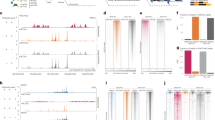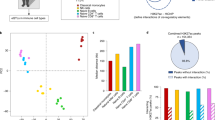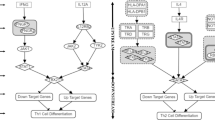Abstract
Transcription factors can have a marked effect on the fate of a cell by establishing the gene expression patterns that determine cellular function. Therefore, a great deal of effort has been invested in identifying and understanding the individual transcription factors that influence key activities. New strategies to identify transcription factor target genes based on their ability to bind to DNA in the nuclear environment have recently been developed, providing an opportunity to address many questions concerning the function of transcription factors. This article discusses the advantages and applications for these new strategies in reference to the developing immune response.
This is a preview of subscription content, access via your institution
Access options
Subscribe to this journal
Receive 12 print issues and online access
$209.00 per year
only $17.42 per issue
Buy this article
- Purchase on Springer Link
- Instant access to full article PDF
Prices may be subject to local taxes which are calculated during checkout



Similar content being viewed by others


References
Szabo, S. J., Sullivan, B. M., Peng, S. L. & Glimcher, L. H. Molecular mechanisms regulating TH1 immune responses. Annu. Rev. Immunol. 21, 713–758 (2003).
Glimcher, L. H. & Murphy, K. M. Lineage commitment in the immune system: the T helper lymphocyte grows up. Genes Dev. 14, 1693–1711 (2000).
Kondo, M., Scherer, D. C., King, A. G., Manz, M. G. & Weissman, I. L. Lymphocyte development from hematopoietic stem cells. Curr. Opin. Genet. Dev. 11, 520–526 (2001).
Ren, B. et al. Genome-wide location and function of DNA binding proteins. Science 290, 2306–2309 (2000).
Iyer, V. R. et al. Genomic binding sites of the yeast cell-cycle transcription factor SBF and MBF. Nature 409, 533–538 (2001).
Ren, B. et al. E2F integrates cell cycle progression with DNA repair, replication, and G2/M checkpoints. Genes Dev. 16, 245–256 (2002).
Weinmann, A. S., Yan, P. S., Oberley, M. J., Huang, T. H. -M. & Farnham, P. J. Isolating human transcription factor targets by coupling chromatin immunoprecipitation and CpG island microarray analysis. Genes Dev. 16, 235–244 (2002).
Weinmann, A. S., Bartley, S. M., Zhang, M. Q., Zhang, T. & Farnham, P. J. The use of chromatin immunoprecipitation to clone novel E2F target promoters. Mol. Cell. Biol. 21, 6820–6832 (2001).
Martone, R. et al. Distribution of NF-κB binding sites across human chromsome 22. Proc. Natl Acad. Sci. USA 100, 12247–12252 (2003).
Horak, C. E. et al. GATA-1 binding sites mapped in the β-globin locus by using mammalian chIp-chip analysis. Proc. Natl Acad. Sci. USA 99, 2924–2929 (2002).
Smale, S. T. & Fisher, A. G. Chromatin structure and gene regulation in the immune system. Annu. Rev. Immunol. 20, 427–462 (2002).
Szabo, S. J. et al. A novel transcription factor, T-bet, directs TH1 lineage commitment. Cell 100, 655–669 (2000).
Szabo, S. J. et al. Distinct effects of T-bet in TH1 lineage commitment and IFNγ production in CD4 and CD8 T cells. Science 295, 338–342 (2002).
Lighvani, A. A. et al. T-bet is rapidly induced by interferon-γ in lymphoid and myeloid cells. Proc. Natl Acad. Sci. USA 98, 15137–15142 (2001).
Lugo-Villarino, G., Maldonado-Lopez, R., Possemato, R., Penaranda, C. & Glimcher, L. H. T-bet is required for optimal production of IFN-γ and antigen-specific T cell activation by dendritic cells. Proc. Natl Acad. Sci. USA 100, 7749–7754 (2003).
Liu, N., Ohnishi, N., Ni, L., Akira, S. & Bacon, K. B. CpG directly induces T-bet expression and inhibits IgG1 and IgE switching in B cells. Nature Immunol. 4, 687–693 (2003).
Pearce, E. L. et al. Control of effector CD8+ T cell function by the transcription factor Eomesodermin. Science 302, 1041–1043 (2003).
Mullen, A. C. et al. Hlx is induced by and genetically interacts with T-bet to promote heritable TH1 gene induction. Nature Immunol. 3, 652–658 (2002).
Afkarin, M. et al. T-bet is a STAT1-induced regulator of IL-12R expression in naive CD4+ T cells. Nature Immunol. 3, 549–557 (2002).
Usui, T., Nishikomori, R., Kitani, A. & Strober, W. GATA-3 suppresses TH1 development by downregulation of Stat4 and not through effects on IL-12Rβ2 chain or T-bet. Immunity 18, 415–428 (2003).
Peng, S. L., Szabo, S. J. & Glimcher, L. H. T-bet regulates IgG class switching and pathogenic autoantibody production. Proc. Natl Acad. Sci. USA 99, 5545–5550 (2002).
Sullivan, B. M., Juedes, A., Szabo, S. J., von Herrath, M. & Glimcher, L. H. Antigen-driven effector CD8+ T cell function regulated by T-bet. Proc. Natl Acad. Sci. USA 100, 15818–15823 (2003).
Avni, O. et al. TH cell differentiation is accompanied by dynamic changes in histone acetylation of cytokine genes. Nature Immunol. 3, 643–651 (2002).
Hoffmann, A., Leung, T. H. & Baltimore, D. Genetic analysis of NF-κB/Rel transcription factors defines functional specificities. EMBO J. 22, 5530–5539 (2003).
Hug, B. A., Ahmed, N., Robbins, J. A. & Lazar, M. A. A chromatin immunoprecipitation screen reveals protein kinase Cβ as a direct RUNX1 target gene. J. Biol. Chem. 279, 825–830 (2004).
Townsend, M. J. et al. T-bet regulates the terminal maturation and homeostasis of NK and Vα14i NKT cells. Immunity (in the press).
Antequera, F. & Bird, A. CpG islands as genomic footprints of promoters that are associated with replication origins. Current Biol. 9, R661–R667 (1999).
Hannenhalli, S. & Levy, S. Promoter prediction in the human genome. Bioinformatics 17, S90–S96 (2001).
Ioshikhes, I. P. & Zhang, M. Q. Large-scale human promoter mapping using CpG islands. Nature Genet. 26, 61–63 (2000).
Wells, J., Graveel, C. R., Bartley, S. M., Madore, S. J. & Farnham, P. J. The identification of E2F1-specific genes. Proc. Natl Acad. Sci. USA 99, 3890–3895 (2002).
Oberley, M. J., Inman, D. R. & Farnham, P. J. E2F6 negatively regulates BRCA1 in human cancer cells without methylation of histone H3 on lysine 9. J. Biol. Chem. 278, 42466–42476 (2003).
Odom, D. T. et al. Control of pancreas and liver gene expression by HNF transcription factors. Science 303, 1378–1381 (2004).
Ballestar, E. et al. Methyl-CpG binding proteins identify novel sites of epigenetic inactivation in human cancer. EMBO J. 22, 6335–6345 (2003).
Mao, D. Y. L. et al. Analysis of Myc bound loci identified by CpG island arrays shows that Max is essential for Myc-dependent repression. Current Biol. 13, 882–886 (2003).
Li, Z. et al. A global transcriptional regulatory role for c-Myc in Burkitt's lymphoma cells. Proc. Natl Acad. Sci. USA 100, 8164–8169 (2003).
Cawley, S. et al. Unbiased mapping of transcription factor binding sites along human chromosome 21 and 22 points to widespread regulation of noncoding RNAs. Cell 116, 499–509 (2004).
Stevens, T. A., Iacovoni, J. S., Edelman, D. B. & Meech, R. Identification of novel binding elements and gene targets for the homeodomain protein BARX2. J. Biol. Chem. 279 , 14520 –14530 (2004).
Jishage, M., Fujino, T., Yamazaki, Y., Kuroda, H. & Nakamura, T. Identification of target genes for EWS/ATF-1 chimeric transcription factor. Oncogene 22, 41–49 (2003).
de Belle, I., Wu, J. X., Sperandio, S., Mercola, D. & Adamson, E. D. In vivo cloning and characterization of a new growth suppressor protein TOE1 as a direct target gene of Egr1. J. Biol. Chem. 278, 14306–14312 (2003).
Greenbaum, S. & Zhuang, Y. Identification of E2A target genes in B lymphocyte development by using a gene tagging-based chromatin immunoprecipitation system. Proc. Natl Acad. Sci. USA 99, 15030–15035 (2002).
Ladenburger, E. M., Keller, C. & Knippers, R. Identification of a binding region for human origin recognition complex proteins 1 and 2 that coincides with an origin of DNA replication. Mol. Cell. Biol. 22, 1036–1048 (2002).
Acknowledgements
I thank S. Smale and P. Farnham for being very supportive mentors, and the members of their laboratories I worked so closely with in the past. I also thank K. Beima for helpful discussions and the Leukemia and Lymphoma Society for their generous support.
Author information
Authors and Affiliations
Ethics declarations
Competing interests
The author declares no competing financial interests.
Rights and permissions
About this article
Cite this article
Weinmann, A. Novel ChIP-based strategies to uncover transcription factor target genes in the immune system. Nat Rev Immunol 4, 381–386 (2004). https://doi.org/10.1038/nri1353
Issue Date:
DOI: https://doi.org/10.1038/nri1353
This article is cited by
-
Transcription factor HIF1A: downstream targets, associated pathways, polymorphic hypoxia response element (HRE) sites, and initiative for standardization of reporting in scientific literature
Tumor Biology (2016)
-
Genes targeted by the estrogen and progesterone receptors in the human endometrial cell lines HEC1A and RL95-2
Reproductive Biology and Endocrinology (2009)
-
Pursuing gene regulation 'logic' via RNA interference and chromatin immunoprecipitation
Nature Immunology (2006)
-
Identification of direct DAF-16 targets controlling longevity, metabolism and diapause by chromatin immunoprecipitation
Nature Genetics (2006)
-
Inhibitors of γ-secretase block in vivo and in vitro T helper type 1 polarization by preventing Notch upregulation of Tbx21
Nature Immunology (2005)

